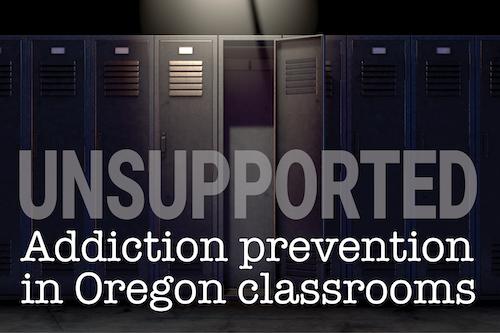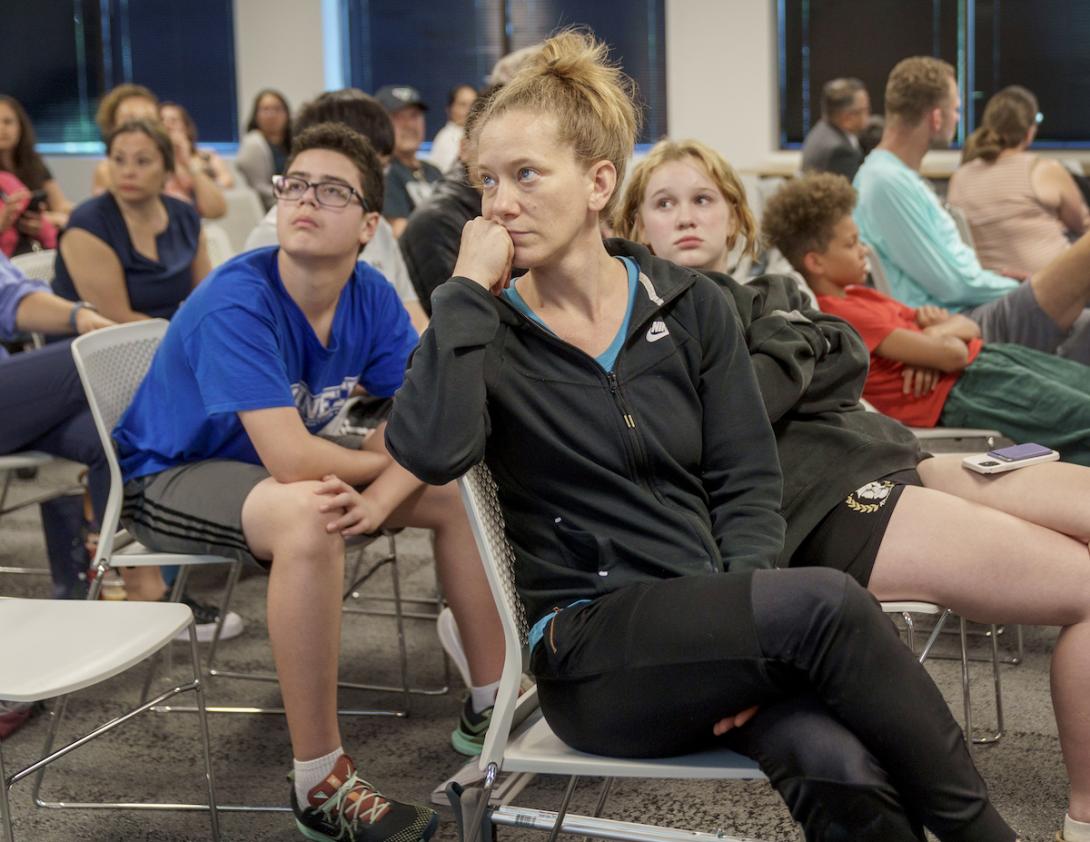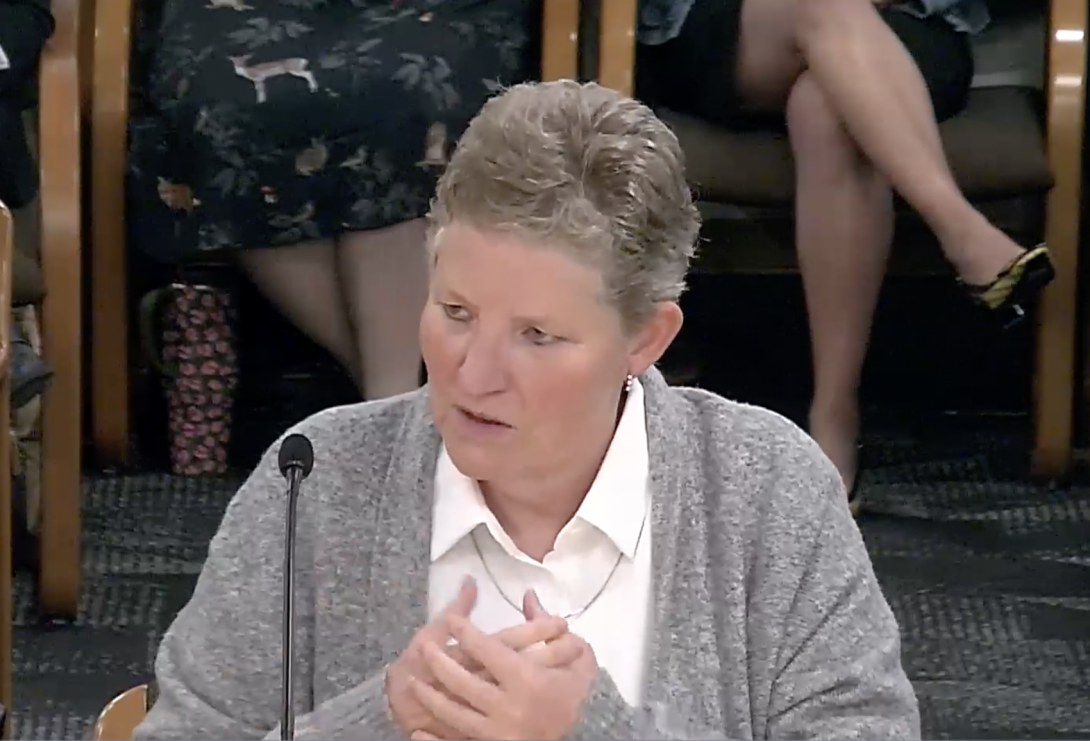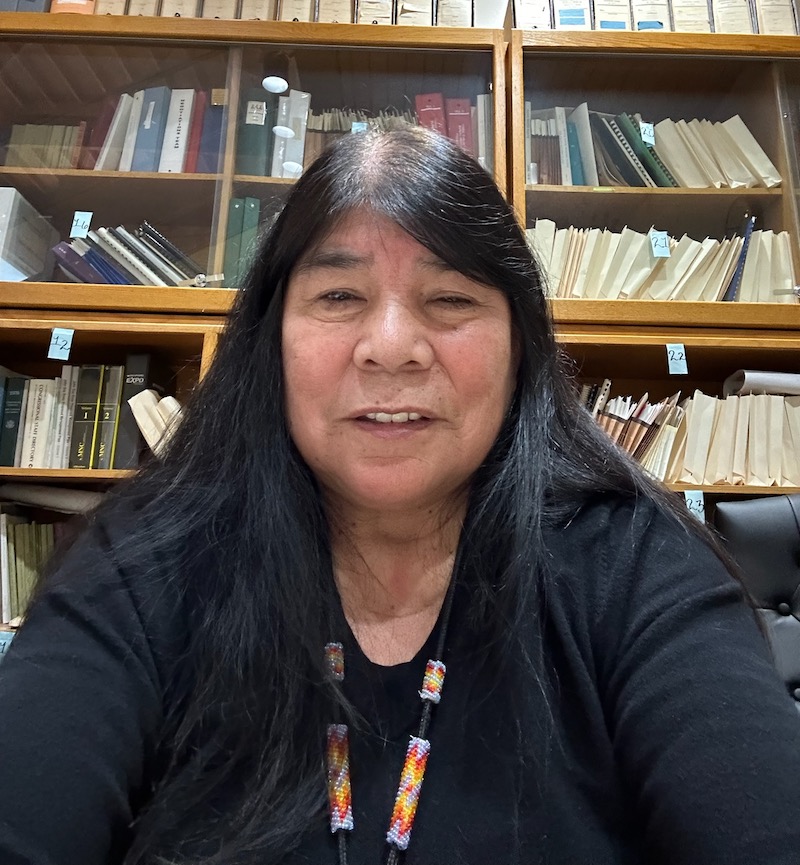
Oregon ranks among the worst states for rates of youth substance use disorder. But as overdoses surge, its public schools get little help from the state to put effective research-backed drug prevention programs in front of their students.
Oregon law requires schools to develop and regularly update programs dedicated to reducing substance use. But interviews and documents show that the state offers scant guidance to meet these standards and does little to hold schools accountable when they don’t.

This article is part of an investigative series showing that as Oregon kids face a world with increasingly dangerous drugs and unparalleled external pressures, the state’s education establishment has failed to adapt.
Effective school prevention is aimed at reducing substance use disorders later in life. It’s characterized by educating young people about substances, addressing factors that might put someone at higher risk and providing healthy alternatives to substance use. Done correctly, it works.
But a review of school districts across the state indicates many struggle to implement evidence-backed programs that emphasize prevention, and in some cases, do little more than what the state requires for general health instruction.
The Oregon Department of Education, tasked with supervising schools and implementing statewide standards and rules, has limited authority when it comes to guiding districts’ substance use prevention efforts. And it lacks funding.
The help that department staff does offer districts on selecting classroom curricula is typically limited to approving a list of general health programs — though districts are not required to use them. There’s no focus or guidance on what makes a good substance use prevention program or curriculum.
The department does not track what programs the districts use, and the agency only gets involved when a district self-reports that it has failed to meet state education standards. Fixing that can take years.
Meanwhile, the Oregon Health Authority, which partners with the Department of Education on health in schools and advises on state health education standards, has struggled to forge relationships with local partners after a reorganization decimated its substance use prevention program in 2015. And some say its efforts still haven’t recovered.
Alanna Russell, a district nurse at Sheridan School District in Yamhill County, said she would like to see more guidance for schools looking to examine the evidence behind substance use prevention materials.
“(Nurses) are trained in evidence-based practice,” she said. “If we’re not selecting an evidence- based program, at worst we could cause harm. At best we could be wasting important resources. That's why I advocate for an evidence-based program.”
Since 2021, the state has poured unprecedented additional funds into its behavioral health system, set up to provide care for people after issues develop. But not into prevention.
“When there is such a desperate need to keep people from dying, you can understand why so many resources get focused on harm reduction and treatment. But in the end, that's kind of short sighted.”
“Over the last two years, the Oregon Legislature has invested over $1 billion into Oregon’s behavioral health system” but included “almost no new funding” for substance use prevention, state officials wrote in a recent grant application.
“When there is such a desperate need to keep people from dying, you can understand why so many resources get focused on harm reduction and treatment. But in the end, that's kind of short sighted,” said Janet Welsh, a prevention scientist at Pennsylvania State University, adding that prevention is cost-effective, while “treatment is very expensive, and relapse is very common.”
Prevention in Oregon schools
In Oregon, so long as substance use materials meet the state’s limited health education requirements, curriculum selection is left to the district's own discretion.
As a result, school-based prevention efforts vary drastically from district to district and, prior to a new database created as part of this reporting project, there was no easily accessible record of what prevention materials each district uses.

“There are districts that do have folks at the administrative level that are specifically responsible for curriculum review and adoption,” said Russell, the district nurse. “But in the smaller districts … a lot of times the people doing this are people like myself.”
The department of education compiles a list of state-approved teaching materials. But the process has limitations. The department’s last health curriculum review was in 2017. Since then, the world kids face has changed dramatically.
Not only that, but when state education officials review a health curriculum they must consider eight required topics, ranging from sexual education to nutrition. According to the department, it gives substance use prevention no special emphasis — despite state law’s stringent requirement that such programs be comprehensive and based on current science.

In many districts, substance use prevention is taught with supplemental materials. But the state doesn’t review these and many aren’t studied rigorously for their effectiveness.
Without help from the state to find effective substance use prevention programs, the Sheridan school district — like many across Oregon — relies on local partners to develop its approach. Specialists at Yamhill County Public Health and the Confederated Tribes of Grand Ronde visit schools to teach prevention.
Research into substance use prevention has become “a lot more robust,” Russell said. “Some sort of compilation from the state or another organization around what are the evidence based programs and what did they find … would be really helpful.”
Expert clearinghouses, such as Blueprints for Healthy Youth Development and the National Institute of Justice’s CrimeSolutions, examine studies of curricula to evaluate how likely they are to reduce substance use. But according to Marc Siegel, the education department’s communications manager, the department does not consult these clearinghouses or alert school districts to their expertise.
Most educators interviewed indicated that if they’re looking for evidence-based curricula, they look to What Works Clearinghouse, which does not focus on substance use prevention.
Records obtained by the Lund Report show that since 2017, 29 school districts have reported being out of compliance with the state’s substance use prevention education standards. When this happens, the state tries to answer questions and pair the district with resources to help, according to Alexa Pearson, education programs manager.
Records show some districts remain out of compliance for years but face no consequence.
The Eugene 4J school district first reported being out of compliance in 2020. The district only taught substance use prevention curriculum in 9th grade, rather than each year as required by law. State officials met with the district twice regarding the issue and granted it multiple extensions. Last year the department sent the district a notice of “failure to complete proposed actions to come back into compliance.”

In a March 21, 2023 letter, Colt Gill, then the state deputy superintendent of instruction, warned the district that the state could withhold funding if Eugene didn’t fix the problem.
In May, the department of education approved the district’s request for a waiver and its plan to correct the violation. The district later adopted a new health curriculum and pulled together a health work group to oversee it — meeting state standards for the first time in four years.
No state funding for drug prevention
The Oregon Health Authority is charged with assisting county health officials to encourage substance use prevention across Oregon. The agency reviews grant applications and distributes funding.
The agency also works with the education department to collaborate on issues of health education. Recently, these efforts have included recommendations on new health education standards and creating the Fentanyl & Opioid Response Toolkit for Schools.
But funding for prevention is tight, with most funds coming from the federal Centers for Disease Control and the Substance Abuse and Mental Health Services Administration.
“It’s harder for us to tell the story of prevention” to obtain funding, said Prevention Systems Manager Tatiana Dierwechter of the health authority. Prevention aims to stop substance use problems before they happen, and the impact may not be so easily seen.
So while overdose rates in the state have increased, funding for substance use prevention hasn’t.
Prevention leaders in Oregon say they have had to make do without new funds while competing for limited grants.
On Oct. 18, Debby Jones, a certified prevention specialist in Wasco County, explained to lawmakers how grant money made a difference in her community.

In 2020, Wasco County used grant funding to implement the substance use prevention program “What’s Strong With You” in The Dalles Middle School. Since then, the school has seen a 68% decrease in juvenile referrals, she said.
But grant funding only reaches a handful of communities across the state. Without it, Jones said state funds don’t cover her position.
Last year, an analysis of substance use disorder services found that over half of providers reported they could not meet current demands for prevention.
“We have examples of what happens when prevention is adequately or fully funded,” said Dierwechter to the Committee on Addiction and Community Safety Response. Tobacco sales have fallen dramatically over the last two decades.
Where tobacco prevention was slated to receive $78 million in the last two-year state budget cycle, only $10 million was allocated for alcohol and other drug prevention.
Oregon system used to be different
Caroline Cruz, a top health official for the Confederated Tribes of Warm Springs, sits on the state Alcohol and Drug Policy Commision. From 1987 to 2009, she helped lead Oregon prevention work at the state Addiction and Mental Health division.
“We wanted to make sure that we were doing prevention, not intervention,” Cruz said. In addition to serving as tribal liaison, she was the state’s first certified prevention specialist, and worked to pave the way for others to get their certification.
The division, then part of the Department of Human Services, required counties to submit detailed prevention plans and worked closely with local substance use prevention providers to guide and monitor their efforts.
In 2015, top state officials moved substance use prevention from DHS in Salem to Portland, where it became part of the Oregon Health Authority’s Public Health Division.
Facing a major unpaid commute, over time much of the team took other positions or quit, according to several people including former state employees like Cruz. With them went relationships forged with local advocates and providers over the years. Community partnerships — which are considered a potent tool for prevention — suffered.

Before the change, the state had a robust prevention system, said Cruz. The shift, she added, “just pretty well destroyed” it.
Rodney Wambeam, a prevention researcher who helped evaluate prevention strategies in Oregon before and after the change, said the transfer meant a change in approach away from community relationships to focus on big-picture, socio-economic factors.
Public health specialists tend to “think much more environmentally than … at that sort of individual program level,” said Wambeam.
A survey of local prevention partners in 2017 found that they felt that the new system undervalued their expertise and experience.
Funding sources and general services of state prevention work generally stayed the same, according to health authority spokesperson Jonathan Modie. But it’s unclear if the relationship with local partners have been restored.
According to Cruz, it hasn’t. “I know that you can’t go backwards, but there’s no need for us to reinvent the wheel when the structure was there,” she said.
Ideas floated mirror Washington
In December, Oregon’s Alcohol and Drug Policy Commission issued recommendations to the state Legislature intended to reduce overdose deaths, including increased substance use prevention funding for Oregon counties and Tribes.
Also recommended was an analysis of current prevention in Oregon that includes community coalitions and school partnerships. The commission also recommended the creation of a statewide hub aimed at identifying strategies to make the state substance use prevention system more effective.
The recommendations reflect some of the prevention strategies used in Washington state, where officials work with schools and scientists at Washington State University to promote evidence-backed classroom practices.
That state also promotes a Community Prevention Wellness Initiative, which prioritizes work with a robust network of about 100 community based organizations across the state.
It’s unclear how many similar community coalitions exist in Oregon. When asked, Modie at Oregon Health Authority identified the state’s system of regional health equity coalitions, which do not have a specific focus on prevention. The agency also works with 10 federally funded Drug Free Community coalitions representing a small fraction of Oregon’s counties.
According to Cruz, effective prevention hinges on bringing communities and the rest of the system together. “It’s not going to happen overnight. But if there is no structure and no one is leading the ship it's going to fail,” she said.
A related subject are teeth issues with drug related lack of help from the state that come from this lack of help. There is now medicine that when painted of the cavities of teeth that are highly associated with illicit drugs that not only stops this the cavity but also prevents further cavities in other teeth. The only compliance needed is permission to apply it. This medicine should be required with any person with active caries, the infectious process of getting cavities, to help get the infection under control before any fillings are done.
Mike Shirtcliff DMD